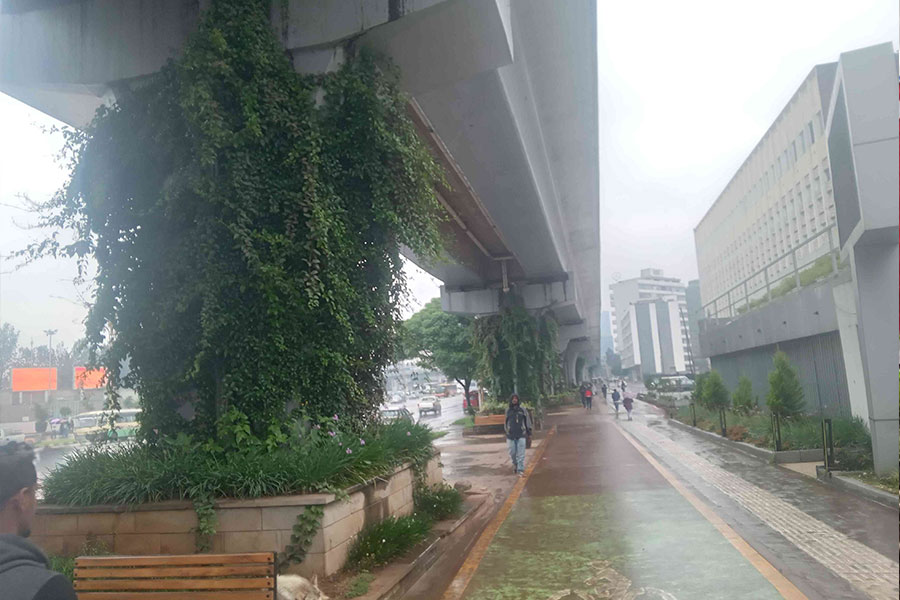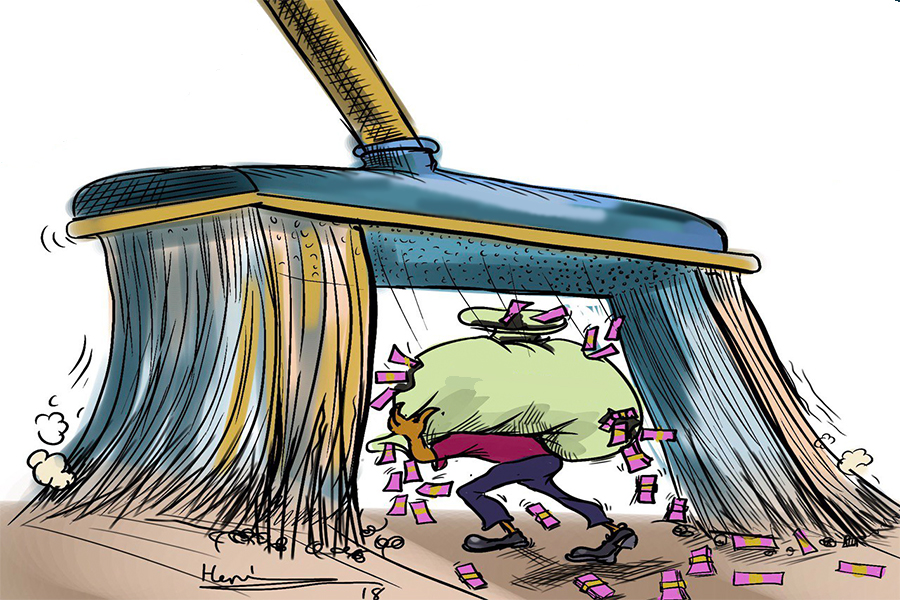
My Opinion | Jul 31,2021
A new bill proposing the establishment of a special fund, potentially worth billions of Birr, was presented to the Ethiopian parliament last week. The bill, co-authored by the Ministry of Finance and the Ethiopian Forestry Development, aims to provide sustainable domestic financing for green legacy initiatives and the restoration of degraded land.
Under the management of the Climate Resilient Green Economy Facility (CRGEF), a 13-year-old initiative under the Ministry, the fund is set to be up to one percent of the federal budget. The CRGEF was initially created to build a climate-resilient middle-income economy by 2025, following the 17th session of the United Nations Framework Convention on Climate Change (UNFCCC) Conference of the Parties.
Officials believe it will provide financial support for environmental projects.
Mikias Sime, the program coordinator, said it will demonstrate the government's commitment to climate change projects and attract international financing. He noted effective coordination was needed among stakeholders to allocate resources properly.
"The financing has been cluttered so far," Mikias told Fortune.
A digital platform, upgraded from an aid management system, will track the progress of climate projects across Ethiopia. The Fund's daily operations, including project approvals and strategic decisions, will be overseen by a steering committee chaired by a Ministry of Finance official and a deputy from the Ministry of Agriculture.
The committee will oversee the Fund's daily activities, including project approvals, strategies, and decisions regarding project termination. Projects in regional states can request funding through the Ethiopian Forestry Development(EFD), with final approval granted by the Ministry of Finance if the regions provide a matching fund.
Nearly half of Ethiopia's 110 million hectares of land have become degraded, with 11 million hectares in critical condition, illustrating the dire need for land restoration.
Fanosie Mekonen, head of Natural Resource Development Protection & Utilisation at the Ministry of Agriculture, refers to an additional four million hectares of land impacted by acidity, primarily in Oromia, Southern and Amhara regional states, as a further burden. He said major financial resources will be needed to restore lands, which are also affected by excess salt in Afar, Somali, and BeniShangul Gumuz regional states.
"Massive resources are needed for us to pull through," Fanoise told Fortune.
He hopes that 22 million hectares will be restored by 2030 through a combination of technical initiatives, including lime, gypsum, and water management projects.
Gabi Rasu Zone in Afar exemplifies the disproportionate impact of soil degradation in Ethiopia's lowlands. A quarter of the 80,000hct of land has degraded, exacerbated by the lack of agro-technology tools. Abdu Ali, the head of the zone, points to the overapplication of fertiliser, cultivation and salty water resources as peculiar sources of pain.
"There is a serious problem," he told Fortune.
Abdu said commercial horticulture farms have faced difficulties due to the incremental temperature reaching 47 degrees Celsius, leaving banana and papaya produce scorched by the searing weather. He said continued financial support from development organisations is needed to help adjust to deteriorating climatic conditions.
"Investors are challenged by unpredictable humidity and poor weather," Abdu says.
Commercial agriculture farms have faced significant challenges nationwide, with a mere 41pc of the 2.1 million hectares allotted to them being developed due to weather, poor infrastructure, and a lack of finance.
The latest Country Climate & Development Report (CCDR) on Ethiopia by the World Bank points to the need for a mix of private and public investment to develop climate-resilient infrastructure and prevent worsening levels of food insecurity. The Ministry of Planning & Development has created a specialised directorate to navigate the complications arising from the impacts of a changing global climate.
Michael Hordofa, a senior coordinator at the Climate Change Directorate, said carbon emissions from other countries have pushed the composition in the atmosphere to 500tns in Ethiopia this year. A mere 0.04pc of the emission comes from local sources. The official said overgrazing and deforestation contribute the most to the high carbon content while transport accounts for around 11pc.
"An international coordinative effort is necessary," he said.
According to Michael, a commitment made three years ago to 310 billion dollars in financing for climate impact mitigation interventions closely aligns with the Paris Climate Agreement's goals and creates a green economy. The figure is contingent on the country providing around six billion dollars annually to climate initiatives, which is two billion dollars higher than Ethiopia's highest export revenue, with the rest coming from international sources.
He points to afforestation, reforestation, non-motorised vehicles, and the transition from larger to smaller livestock herding in agriculture.
The World Bank's climate report on Ethiopia estimates that the GDP will shrink by 1-1.5pc annually, pushing millions of Ethiopians into poverty.
"Things are rapidly deteriorating, Michael told Fortune.
The official said carbon trading efforts are picking up steam, referring to five million Euros reportedly attained from sales to the European Union last year from forests in Bale, Oromia Regional State.
Perhaps the most significant goal toward climate resiliency has been the massive undertaking spearheaded by Prime Minister Abiy Ahmed (PhD), which aims to plant 50 billion trees under the Green Legacy Initiative.
Adefris Worqu, coordinator of the Initiative at the EFD, said special funds and intensive financial resources will be needed to advance to the next stages of the project. He recalls EFD repeatedly asking for special funding from the PM office as the project's cost increased.
"Plans kept outpacing finances," Adefres told Fortune.
According to Adefris, careful use of the available finances is necessary to ensure success in all climate change projects, as previous allocations were being refunneled from other sectors.
"A dedicated fund is vital," said Adefris.
According to the 2018 National Forest Inventory Report, Ethiopia's forest cover was estimated at 15.7pc. While independent reports are yet to be released, the PM announced last week that coverage reached 23.6pc within five years while revealing plans to reach up to 30pc by 2030.
Environmental economists like Abebe Damtew (PhD) said that the number of trees that have survived remains unknown, as plants have a roughly 70pc survival rate. He points out that no drop in foreign financing has been directed towards the Green Legacy project.
"There is a lack of follow-up on how many trees survive," Abebe told Fortune.
The expert has observed the definition of a forest change, with skyrocketing double-digit growth figures reported and young saplings considered part of the forest. He also recalled mixed success in pulling finances as per the CRGE due to inadequate lobbying and a lack of recognition of the lucrative economic potential.
"Domestic financing is important," Abebe said, "but checks and balances will be critical."
PUBLISHED ON
Jun 22,2024 [ VOL
25 , NO
1260]

My Opinion | Jul 31,2021

Fortune News | Sep 29,2024

Commentaries | Dec 31,2022

My Opinion | Feb 25,2023

Radar | Apr 30,2021

Fortune News | Dec 19,2021

Commentaries | Jul 15,2023

Radar | Sep 08,2019

Radar | May 31,2020

In-Picture | Sep 07,2025

Dec 22 , 2024 . By TIZITA SHEWAFERAW
Charged with transforming colossal state-owned enterprises into modern and competitiv...

Aug 18 , 2024 . By AKSAH ITALO
Although predictable Yonas Zerihun's job in the ride-hailing service is not immune to...

Jul 28 , 2024 . By TIZITA SHEWAFERAW
Unhabitual, perhaps too many, Samuel Gebreyohannes, 38, used to occasionally enjoy a couple of beers at breakfast. However, he recently swit...

Jul 13 , 2024 . By AKSAH ITALO
Investors who rely on tractors, trucks, and field vehicles for commuting, transporting commodities, and f...

Oct 25 , 2025
The regulatory machinery is on overdrive. In only two years, no fewer than 35 new pro...

Oct 18 , 2025
The political establishment, notably the ruling party and its top brass, has become p...

Oct 11 , 2025
Ladislas Farago, a roving Associated Press (AP) correspondent, arrived in Ethiopia in...

Oct 4 , 2025
Eyob Tekalegn (PhD) had been in the Governor's chair for only weeks when, on Septembe...